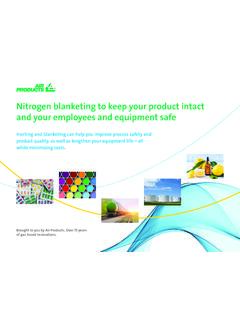Transcription of Ethylene Production - Emerson
1 Chapter 1. Ethylene Production NOTE: The following chapter is the debottlenecking at existing plants, as well as first of many to be released as part greenfield plants being built in the Middle East and of a Chemical sourcebook. These Asia. Due to the change in market conditions and chapters will be released to eDocs the economy, there is an over supply of Ethylene as they are completed and when capacity. Many plants have been taken offline in fully developed, compiled into one this time period, are operating at reduced rates, or sourcebook. are undergoing turnarounds . As the Ethylene market rebounds, capacity will increase. In fact, Ethylene is one of the most important based on new capacities announced and plants petrochemical intermediates and is a feedstock for that are under construction, global Ethylene many various products.
2 End products made with capacity is expected to be at 162 million tpy by Ethylene include food packaging, film, toys, food 2012, ahead of the demand growth. containers, bottles, pipes, antifreeze, carpets, insulation, housewares, etc. Chemicals that are There are five major licensors of Ethylene plants: made from Ethylene in order to produce these end KBR; Technip; Linde; Shaw, Stone . products are polyethylene, Ethylene dichloride, and Lummus. While Ethylene Production differs Ethylene oxide, ethylbenzene, and vinyl acetate, slightly by licensor, the overall process is fairly just to name a few. similar (see Figure 1 1). There are also some differences in the process coming from the type of Global Ethylene capacity utilization has remained feedstock being used.
3 Some of these differences above 90% since 2004 until 2008's economic will be highlighted. This chapter will cover the meltdown. In 2007, 2 million tonnes per year (tpy) general steps in Ethylene Production and will of Ethylene capacity was added, according to the discuss the critical valve applications within an Oil & Gas Journal. As of January 1, 2009, global Ethylene plant, what valve challenges those capacity was million tpy. Capacity has been applications present, and the recommended added in recent years due to expansions and Emerson solutions. Figure 1 1. General Ethylene process (naptha fed cracker). Figure 1 2. General Ethylene furnace schematic I.
4 Furnace products such as Ethylene and propylene. Long residence times will favor the secondary reactions. The two primary feedstocks for Ethylene Production are naphtha and natural gas (ethane, Table 1 1. Furnace Reactions propane, butane, etc.). The first step in the Secondary Primary Reactions Production of Ethylene is to take the feedstock and Reactions crack it into Ethylene and other various products in Ethylene C4 products a furnace. This process is called pyrolysis. Propylene C5 products Pyrolysis is the thermal cracking of petroleum Acetylene C6 products hydrocarbons with steam, also called steam Feedstock/steam Hydrogen Aromatics cracking.
5 The main types of commercial furnaces Methane C7 products are the ABB Lummus Global furnace, Millisecond Heavier Etc. furnace (KBR), Shawt furnace (ultraselective products cracking furnace), Technip furnace, and the Linde PYROCRACKt furnace. See Figure 1 2 for a Maximum Ethylene Production requires a highly general schematic of an Ethylene furnace. saturated feedstock, high coil outlet temperature, low hydrocarbon partial pressure, short residence The feed hydrocarbon stream is pre heated by a time in the radiant coil, and rapid quenching of the heat exchanger, mixed with steam, and then cracked gas. Valves in the furnace section play a further heated to its incipient cracking temperature critical role in maximizing Ethylene Production and (932_F to 1256_F or 500_C to 680_C depending throughput.)
6 Upon the feedstock). At this point, it enters a reactor (typically, a fired tubular reactor) where it is There are three critical control valve applications in heated to cracking temperatures (1382_F to the furnace area: dilution steam ratio control, feed 1607_F or 750_C to 875_C). During this reaction, gas control, and fuel gas control. Each will be hydrocarbons in the feed are cracked into smaller discussed in further detail in the subsequent text. molecules, producing Ethylene and co products. The cracking reaction is highly endothermic, Dilution Steam Ratio Control therefore, high energy rates are needed. The The quantity of steam used (steam ratio) varies cracking coils are designed to optimize the with feedstock, cracking severity, and design of temperature and pressure profiles in order to the cracking coil.
7 Steam dilution lowers the maximize the yield of desired or value products. hydrocarbon partial pressure, thereby enhancing Short residence times in the furnace are also the olefin yield. Because of this, it is important to important as they increase the yields of primary obtain the appropriate ratio and maintain proper 1-2. control of that ratio. Steam helps to reduce coking Feed Gas Control deposits by reacting with coke to form carbon dioxide (CO2), carbon monoxide (CO), and The feed into an Ethylene furnace can be ethane, hydrogen (H2) and also reduces the catalytic effect propane, butane, gas oil, or naphtha. Variation in of the reactor coil's metal walls, which tend to the type of feedstock used is related to availability.
8 Promote coke formation. An improper ratio Plants in the Middle East tend to use natural gas reduces efficiency of the cracker and can result in feedstock because it is plentiful in the region and the need for more decoking cycles, thus resulting is a low cost feedstock. Asia has a large in less furnace uptime. It is necessary that availability of naphtha and, therefore, is inclined to decoking be performed on a regular basis. This is use it more frequently as a feedstock. Plants can typically done by burning out the coke with a also be designed to handle different types of mixture of steam and air. Time intervals for feedstocks, allowing them more flexibility to decoking will depend upon several factors change based upon availability and cost.
9 Including, but not limited to the type of furnace, how the process is operated, feedstock type, and the types of coils utilized. The feed gas control valve controls the flow of feedstock used in the Ethylene plant. Tight control Precise control of the steam dilution valve is of the valve is critical in the steam dilution valve so necessary to maintain the proper steam ratio, that the proper reaction ratio can be maintained which can greatly affect the efficiency of the within the furnace. Control of the reaction ratio of furnace. Due to the process conditions seen by the feedstock to steam will affect the reaction dilution steam control valve, it requires the use of efficiency and percentage of conversion to graphite packing.
10 Graphite packing often leads to Ethylene . Due to the process conditions, the use of higher friction than one would see with the use of graphite packing is required. Graphite packing PTFE packing. This added friction contributes to often leads to higher friction than with the use of high deadband and high variability, thus the loop PTFE packing. This added friction contributes to may become unstable. With high deadband and high deadband and high variability, thus the loop variability, it's difficult to have precise control within may become unstable in automatic. With the high the valve, which leads to issues controlling the deadband and variability, it's difficult to have loop.














